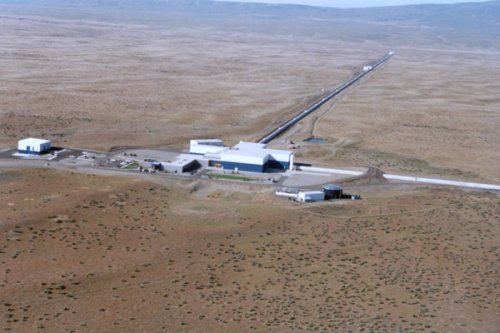
Physicists in the US and Australia have used the quantum nature of light to make an important step towards improving the sensitivity of kilometre-sized interferometers used to search for gravitational waves. By using light in a “squeezed state” they achieved a 44% improvement in sensitivity of a prototype gravitational-wave detector.
This figure could reach 300% in a full-scale detector and the team believes that squeezed-light sources could be tested in working detectors such as LIGO within 1-3 years. More sensitive detectors would be able to search larger volumes of the universe for sources of gravitational waves, making their detection more likely.
Gravitational waves are ripples in the fabric of space-time that are produced when massive bodies accelerate through space. Predicted by Einstein’s general theory of relativity, the waves are very weak — even for events as extreme as supernova explosions or collisions between neutron stars and black holes — and have therefore not been detected directly.
Physicists have built a number of very large interferometers to try to look for such waves, including two LIGO facilities in the US, the Virgo detector in Italy, the GEO 600 facility in Germany, and the TAMA project in Japan. These devices split a laser beam into two components at 90° to one another, sending each component down a separate “arm” that can be several kilometers long. The beams bounce off “test masses” with highly reflective mirror surfaces at the end of each arm. The beams are then recombined on a beamsplitter before being detected by a photodetector.
Tiny changes
A gravitational wave passing through the device stretches one of the arms and compresses the other, therefore changing the interference pattern at the photodetector. However, the change to the length of the arms will be tiny — about 10-18 m — and the associated change in the interference pattern will therefore also be extremely small. Indeed, existing detectors have so far not detected any gravitational waves.
The next generation of detectors should begin operation in the early 2010s and they will be so sensitive that their performance will be limited by noise that arises from the quantum nature of the laser light. Quantum theory requires the product of the uncertainties in two quantities that are associated with the phase and amplitude of the light to be greater than a minimum value. In an interferometer that measures the phase of light, this means that there will always be some “quantum” noise in the detector.
Fortunately, the uncertainty principle does not prevent physicists from minimizing this noise by “squeezing” the quantum state of the light such that the uncertainty in amplitude becomes large, while the uncertainty in phase becomes small. Such squeezed states were first demonstrated experimentally in 1985, a few short years after they were proposed for use in gravitational wave detectors. Now a team of LIGO physicists led by Nergis Mavalvala and Keisuke Goda of the Massachusetts Institute of Technology have proven experimentally that a squeezed source can be used to improve the sensitivity of a prototype detector (Nature Physics doi:10.1038/nphys920) .
Squeezing light
The squeezed state was created by passing infrared laser light through two devices that contain special “non-linear” optical materials. In such materials the index of refraction (which affects the phase of the light) changes according to the amplitude of the light.
The source is based on a neodymium-doped yttrium aluminium garnet (Nd:YAG) laser, which fires a continuous beam of 1064-nm wavelength light at a “second harmonic generator”. This creates a beam of light with exactly one-half the wavelength (532 nm) of the laser beam. This shorter-wavelength light is then passed through an “optical parametric oscillator” (OPO), which converts individual 532-nm photons into two 1064-nm photons. The photons emerging from the OPO are in squeezed states such that the quantum noise in the phase of the light is reduced by 9.3 dB compared with the input laser light.
These photons are then introduced into a prototype gravitational wave detector with 40-m long arms at Caltech near Los Angeles. Ideally, the team should have seen about a 300% improvement in the sensitivity of the interferometer, but instead they only managed to get 44%. According to Mavalvala, this shortcoming was expected because of optical losses, which were larger in the prototype than in a working gravitational wave detector.
According to Mavalvala, a 200% improvement in sensitivity would allow LIGO to detect gravitational waves from within a volume of the universe eight times larger than currently possible — boosting the probability that such waves would be detected. Even a modest 44% increase in sensitivity would increase this volume by about a factor of three. Mavalvala told physicsworld.com that their squeezed source could be tested on gravitational wave detectors in the next 1-3 years.
‘Very important step’
James Hough at the University of Glasgow, UK, described the work of the LIGO team as a “very important step towards the implementation of squeezed sources in gravitational wave detectors”. Hough is principal investigator for the UK on the GEO 600 gravitational wave detector, in Hanover, Germany.
There are two other research groups also working on the use of squeezed light in gravitational wave detectors. One group at the University of Hanover is planning to implement a squeezed source on the GEO 600 later this year, according to Hough. The other group is at the Australian National University in Canberra and was the first to show that light at 1064 nm could be squeezed. This was an important breakthrough because all gravitational wave detectors use 1064-nm light from Nd:YAG lasers because they are extremely stable.



